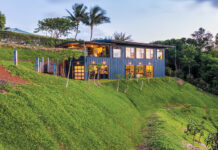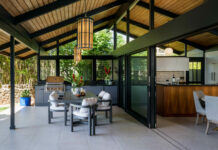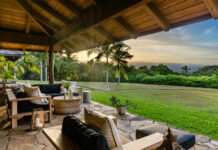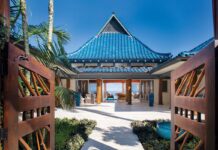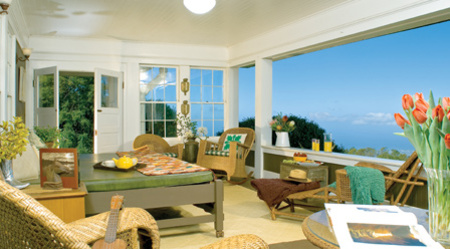 The first time I visited my cousin Sharlene, more than 25 years ago, she was living on O‘ahu in a ground-floor apartment that felt positively subterranean. There were no views to speak of—I don’t even remember windows—but from the first night I stayed over, I was entranced. Sharlene had a lanai.
The first time I visited my cousin Sharlene, more than 25 years ago, she was living on O‘ahu in a ground-floor apartment that felt positively subterranean. There were no views to speak of—I don’t even remember windows—but from the first night I stayed over, I was entranced. Sharlene had a lanai.
Its roof was formed by a second-floor overhang that gave enough shelter for a bed, two chairs, and a small table. Beyond, a tiny yard enclosed by a wooden fence offered privacy and garden space for my green-thumbed cousin. Whenever I visited, this was my guest room. Protected within mosquito netting, I fell asleep counting stars.
Sharlene’s lanai was my introduction to one of the great pleasures of living in Hawai‘i: a room halfway between inside and out. Lanais keep us connected with nature, removing the manmade boundaries that separate us from sunsets and trade winds, the sound of surf or the scent of jasmine. What’s more, lanais adapt to whatever one’s life demands. A lanai can be perfect for entertaining, or sequestering yourself with a good book. A picnic table and grill are the perfect lanai accoutrements, but so are a pair of rocking chairs, or your prize orchid collection. And if you have never watched a meteor shower from the comfort of a hot tub on an upcountry lanai, you have only half lived.
This malleability works both ways. We shape our lanais to suit us, and they reveal things about who we are and what in life we value.
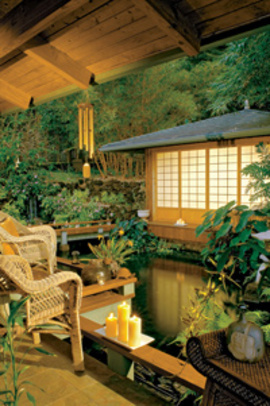 A koi pond and Japanese gardens offer sensory delights, enjoyed from this contemplative lanai.
A koi pond and Japanese gardens offer sensory delights, enjoyed from this contemplative lanai.
A great lanai can be the focus of a home. Ten years ago, when Harlan Hughes and his wife, Judy Anderson, bought a half-acre lot in Kula, the property was little more than “a sloping hillside with a chicken pen and weeds.” From the road, their cottage still looks like a typical ‘ohana unit. Then you enter, and find yourself transported half a world away.
Hughes has transformed this small piece of Maui into a Japanese fable: a one-bedroom dwelling with distinctly Asian accents; a separate structure (with hot tub) that serves as bath and tea house; between and around them, a koi pond, a waterfall, and gardens where statues of Buddha and Kuan Yin sit in repose amid moss rock and zoysia grass. Sliding doors open whole walls to modest lanais designed for sitting and contemplating the view.
Massage-therapist friends found the ambiance of the home so soothing, Hughes and his wife decided to share. “We did the steps with the health department,” he says. “It’s a licensed massage spa, but it’s also our home, so we limit appointments to four a day.” And once a week, the Urasenki Maui Association holds a tea ceremony here for its members.
Hughes designed the gardens and the buildings, inside and out. “I’ve never been to Japan, except in books,” he admits, “but there’s something about Asian sensibilities that touches me.”
He says he knew he’d done it right when a senior citizen who had been born in Japan came to visit. “Harlan,” the older man said, “you honor my culture by what you’ve done.”
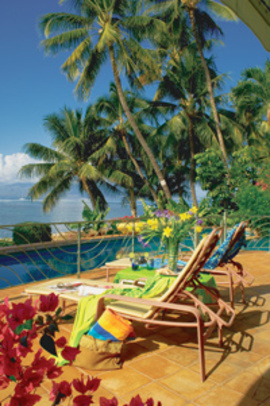 Liquid Assets: Longhi’s Lahaina lanai
Liquid Assets: Longhi’s Lahaina lanai
Bob Longhi is best known as the man who built an award-winning restaurant because he loves to eat. He also loves to entertain.
For 30 years, Longhi’s restaurant has been a Lahaina fixture, with its black-and-white tiled floors, its defiance of right angles, and a killer menu. At the other end of Front Street, Longhi’s—the domicile—is an oceanfront home whose lanai basks in the West Maui sun, between Mediterranean-inspired architecture and a very inviting pool. “I do a lot of partying,” says Bob Longhi, reached the morning after he’d been entertaining a few dozen friends. “You can fit 50 people on my lanai.”
The master of the house has a laissez-faire attitude about the home he has lived in these past 19 years. He spends a lot of time upstairs, enjoying the seclusion of his bedroom, with its second-story lanai, and a meditation tower that looks out over the lawn to the ocean beyond. The rest of the house is open to friends, who are welcome to come and go as they please—though, with a 69-foot lap pool, a wading pool, a hot tub, a sauna, and two steam rooms, it’s hard to imagine why anyone would leave.
Some couples have begun their lives together here. Longhi lends his lanai for wedding parties catered by his daughter. And what could be a more auspicious start to married life? Like the restaurant, Longhi’s home is all curves, based on an idiosyncratic belief that nevertheless seems to work: “I want everything to be round,” he says. “No right angles. That way I create no negative energy, just positive energy.”
The hikie‘e went mauka
A friend of ours has a gracious old home upcountry. From her lanai, you can see across the isthmus to the West Maui Mountains, and beyond them, the islands of Moloka‘i, Lana‘i, and Kaho‘olawe.
Built in 1917, the house was once the residence of the manager of Kaonoulu Ranch, until a tsunami swept through the Spreckelsville home of the ranch owners, who promptly relocated mauka (inland)—3,000 feet higher.
With them, they brought the quintessential piece for a truly kama‘aina lanai: a hikie‘e, or Hawaiian bed. (Its smaller sibling is the pune‘e, or Hawaiian couch.)
“Both are a tradition in the Islands,” says Jamie Clark, an interior designer who is native Hawaiian. “They’re perfect for our lifestyle. You can add a bolster to a pune‘e and use it as a couch. You can play guitar on it; there are no chair arms to get in the way. You can put the baby down to sleep on a hikie‘e. Or hang a mosquito net and you’ve got an instant guest room.”
“When we have guests,” says our friend, the mistress of this most congenial lanai, “the guys will go out there to read the paper, or nap out there in the afternoon. Mostly, we come out here to watch the sunsets.”

